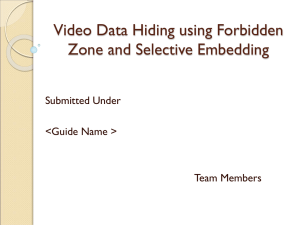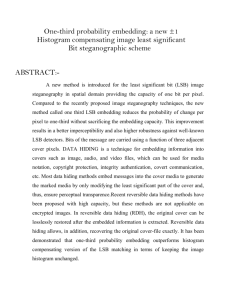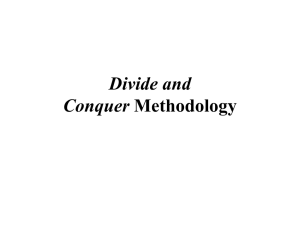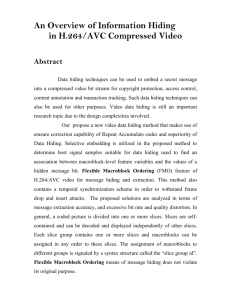pdf - arXiv.org
advertisement
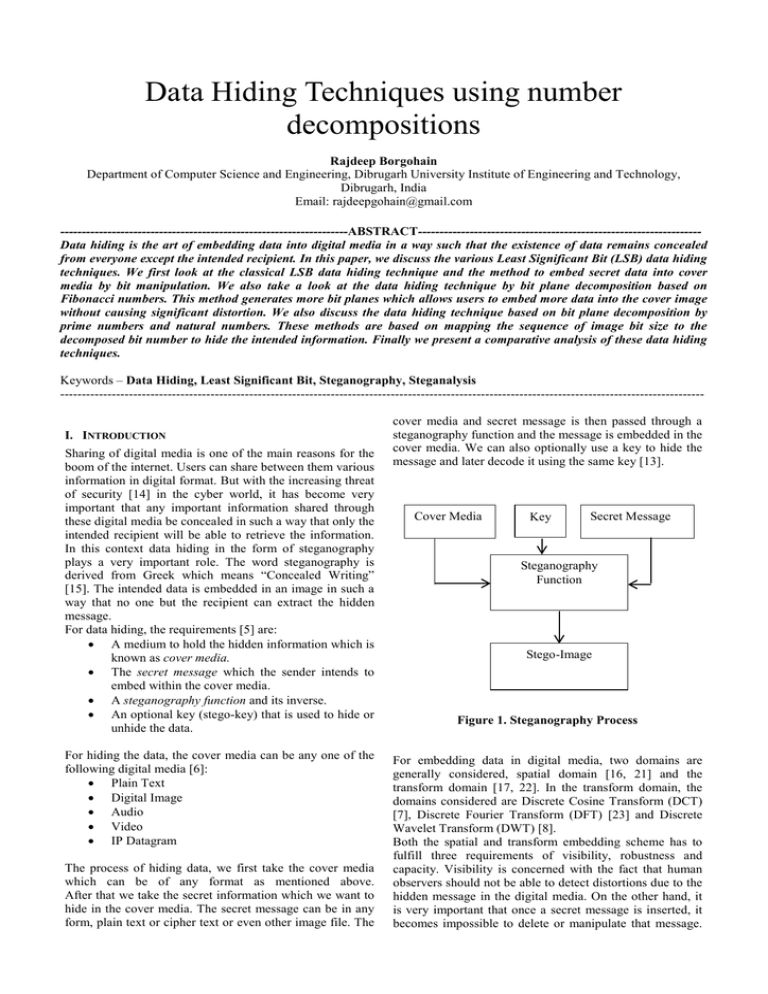
Data Hiding Techniques using number
decompositions
Rajdeep Borgohain
Department of Computer Science and Engineering, Dibrugarh University Institute of Engineering and Technology,
Dibrugarh, India
Email: rajdeepgohain@gmail.com
-------------------------------------------------------------------ABSTRACT-----------------------------------------------------------------Data hiding is the art of embedding data into digital media in a way such that the existence of data remains concealed
from everyone except the intended recipient. In this paper, we discuss the various Least Significant Bit (LSB) data hiding
techniques. We first look at the classical LSB data hiding technique and the method to embed secret data into cover
media by bit manipulation. We also take a look at the data hiding technique by bit plane decomposition based on
Fibonacci numbers. This method generates more bit planes which allows users to embed more data into the cover image
without causing significant distortion. We also discuss the data hiding technique based on bit plane decomposition by
prime numbers and natural numbers. These methods are based on mapping the sequence of image bit size to the
decomposed bit number to hide the intended information. Finally we present a comparative analysis of these data hiding
techniques.
Keywords – Data Hiding, Least Significant Bit, Steganography, Steganalysis
------------------------------------------------------------------------------------------------------------------------------------------------------
I. INTRODUCTION
Sharing of digital media is one of the main reasons for the
boom of the internet. Users can share between them various
information in digital format. But with the increasing threat
of security [14] in the cyber world, it has become very
important that any important information shared through
these digital media be concealed in such a way that only the
intended recipient will be able to retrieve the information.
In this context data hiding in the form of steganography
plays a very important role. The word steganography is
derived from Greek which means “Concealed Writing”
[15]. The intended data is embedded in an image in such a
way that no one but the recipient can extract the hidden
message.
For data hiding, the requirements [5] are:
• A medium to hold the hidden information which is
known as cover media.
• The secret message which the sender intends to
embed within the cover media.
• A steganography function and its inverse.
• An optional key (stego-key) that is used to hide or
unhide the data.
For hiding the data, the cover media can be any one of the
following digital media [6]:
• Plain Text
• Digital Image
• Audio
• Video
• IP Datagram
The process of hiding data, we first take the cover media
which can be of any format as mentioned above.
After that we take the secret information which we want to
hide in the cover media. The secret message can be in any
form, plain text or cipher text or even other image file. The
cover media and secret message is then passed through a
steganography function and the message is embedded in the
cover media. We can also optionally use a key to hide the
message and later decode it using the same key [13].
Cover Media
Key
Secret Message
Steganography
Function
Stego-Image
Figure 1. Steganography Process
For embedding data in digital media, two domains are
generally considered, spatial domain [16, 21] and the
transform domain [17, 22]. In the transform domain, the
domains considered are Discrete Cosine Transform (DCT)
[7], Discrete Fourier Transform (DFT) [23] and Discrete
Wavelet Transform (DWT) [8].
Both the spatial and transform embedding scheme has to
fulfill three requirements of visibility, robustness and
capacity. Visibility is concerned with the fact that human
observers should not be able to detect distortions due to the
hidden message in the digital media. On the other hand, it
is very important that once a secret message is inserted, it
becomes impossible to delete or manipulate that message.
This is the requirement for robustness. Moreover, the
capacity of the digital media should be kept in
consideration while inserting the message. These three
factors are dependent on each other and a balance must be
maintained between them as increase in one of the factors
leads to the decrease in other [9].
Though, there are many data hiding techniques [2, 3, 4], in
this paper, we consider the spatial domain of data hiding.
We discuss the various data hiding techniques using bit
manipulation of the lowest significant bit (LSB). We take a
look at how the bit planes can be increased by various
number decomposition methods without compromising on
the three requirements of visibility, robustness and
capacity.
The rest of the paper is organized as follows. In Section 2
we take a look at the classical LSB data hiding technique.
Here we discuss how secret text can be embedded in cover
image using LSB manipulation. Section 3 of the paper
contains the Fibonacci LSB data hiding technique. Section
4 of the paper contains the LSB data hiding technique using
decomposition of prime numbers. The approach for
decomposition using prime numbers is discussed here.
Section 5 contains LSB data hiding by natural numbers.
Here the decomposition of bit planes by natural numbers is
discussed. In Section 6 we present a comparative analysis
between the various LSB data hiding methods. Finally, in
Section 7, we present the conclusion for the paper.
II. CLASSICAL LSB DATA HIDING TECHNIQUE
[10001001 10001110 10000010]
[11110101 01001010 10001011]
So to accommodate our desired character, ‘A’, we have to
make the following modifications:
[10010101 10101010 11110100]
[10001000 10001110 10000010]
[11110100 01001010 10001011]
So, basically we have changed the values of 3 bit to
accommodate our desired character.
Though, classical data hiding is simple to implement, it is
vulnerable to image manipulation [15].
III. LSB DATA HIDING USING FIBONACCI NUMBERS
Battisti et al. [1] proposed a method of embedding data into
digital media by decomposition of Fibonacci number
sequence which allowed different bit plane decomposition
when compared to the classical LSB scheme.
The Fibonacci sequence, named after Leonardo of Pisa,
also known as Fibonacci, is a sequence of numbers in the
following integer sequence:
0, 1, 1, 2, 3, 5, 8, 13, 21, 34, 55, 89 …
One of the simplest implementation of data hiding
technique is the classical least significant bit data hiding
technique [18]. The technique is based on manipulation of
the least significant bits of the carrier image to
accommodate the hidden message.
The insertion of LSB varies according to the number of bits
in an image. For an 8 bit image, the value of 8th bit, which
is the least significant bit of each pixel, would be modified
and the secret message would be embedded [19].
Suppose if we wanted to insert the letter ‘A’ into an image.
The binary equivalent of ‘A’ is 10000001. Now if our
sample image of 8 bit has the following pixel values:
The Fibonacci numbers are defined by a recurrence
relation:
10101010 10001010 11111111 010110101 10101010
10101010 10001011 10101111
The bit planes are now decomposed based on the Fibonacci
sequence. The main drawback of this approach is that of
redundancy and to counter that and obtain a unique
representation, Zeckendorf theorem [20] is used.
To embed the intended message in the cover image, it is
decomposed into bit planes by using Fibonacci pdecomposition. The Zeckendorf condition is checked for
each bit to be modified. If the condition is fulfilled, the bit
is inserted otherwise the bit following it is considered.
So, embedding the binary equivalent of ‘A’ i.e.
10000001would change the pixel values of our sample
image to:
101010101 10001010 111111110 010110100 10101010
10101010 10001010 0101111
In our sample image the least significant bit value of pixel
1, 3, 4 and 7 have been changed.
Similarly, for an image of 24 bit, we need to change the
RGB (Red Blue Green) color values. Suppose our sample
image has the following pixel values,
[10010101 10101010 11110101]
𝐹𝑝 (0) = 𝐹𝑝 (1) = 1
𝐹𝑝 (𝑛) = 𝐹𝑝 (𝑛 − 1) + 𝐹𝑝 (𝑛 − 𝑝 − 1),
∀ 𝑛 ≥ 2, 𝑛 ∈ 𝑁
IV. LSB DATA HIDING USING PRIME NUMBERS
LSB data hiding using prime numbers is a data hiding
technique proposed by Dey et.al [10] as an improvement
over the Fibonacci numbers data hiding technique proposed
by Battisti et. al. The main idea of the work was to use the
prime number decomposition and generate new set of bit
planes and embed information in these newly generated bit
planes with minimal distortion.
In this approach, the researchers took an image of m bits
and increased the number of bit planes to n, where the
value of n was equal or greater than or equal to the number
of bit planes of the image. This was achieved by converting
the bit planes of the image to another number system using
prime numbers as the weighted function. This resulted in
the increase of number of bits and consequently it could be
used for hiding data in higher bit planes with minimal
distortion.
For decomposition, the weight function was defined as:
For embedding the data into the k-bit image, a number n is
chosen in a way such that all pixel values in the range of
[0, 2k – 1] could be represented using first n numbers,
which resulted in generation of n virtual bit planes .
The value of n can be found out by the formula,
𝑃(0) = 1, 𝑃(𝑖) = 𝑝𝑖 ∀ 𝑖 ∈ 𝑍 + , 𝑝𝑖 = 𝑖 𝑡ℎ Prime
After finding the value of n, a k-bit to n-bit map is created
and all valid representations in natural numbers system are
marked. Now, for each pixel a virtual bit plane is chosen
and the secret data is embedded. If the virtual bit plane
matches the mapping system, the hidden data is kept
otherwise it is discarded. After insertion of the secret
message, the natural number system is converted back to its
original binary form and the stego-image is achieved.
To extract the message from the stego-image, all the pixels
with embedded data bit are converted to the natural number
decomposition, and the secret message bits are extracted.
Finally, all bits are combined together to get the embedded
hidden message.
In case of any ambiguity, the lexicographically higher
number is given preference.
For embedding the data in the image, a number n is chosen
in such a way that all possible pixel values in the range of
[0, 2k - 1] could be represented using first n prime number,
so that n virtual are achieved after the decomposition.
The value of n can be found out by the formula,
𝑛−1
�
𝑖=0
𝑝𝑖 ≥ 2𝑘 − 1
After finding the prime numbers, a k-bit to n-bit sequence
is mapped, marking all the valid prime number in the
system. Now, for each pixel of the image, a virtual bit plane
is chosen and secret data is embedded is by modifying the
corresponding virtual bit plane by the desired information
bit by bit. If the resulting sequence of data after embedding
the data matches the k-bit to n-bit mapping, the bits are
kept otherwise it is discarded. After insertion of the hidden
data, the resultant prime number system is converted back
to the original binary system and the stego-image is
achieved.
For extraction, each pixel with the hidden information is
converted into prime decomposition and from those bit
planes, the secret message is extracted. All the bits are
combined together to get the final message.
−1 ± �2k+3 + 9
𝑛≥
2
VI. COMPARISON OF LSB DATA HIDING TECHNIQUES
In the previous section, we have looked at the various
techniques for data hiding using number decomposition.
Here, we present a comparative analysis between the
various data hiding techniques using number
decomposition.
6.1 Technique Used:
Classical
Classical LSB data hiding uses the simplest
LSB
approach. In classical LSB data hiding, the
least significant bit of a pixel is manipulated
in order to embed the desired image.
Fibonacci
Technique
In Fibonacci approach, the bit planes are
decomposed so as to generate more bit planes
and then the secret message is embedded on
following the Zeckendorf theorem.
LSB data
hiding by
prime
numbers
In LSB data hiding using prime numbers, the
bit planes are decomposed by using sum of
prime numbers. After that the secret message
is embedded lexicographically.
LSB data
hiding by
natural
numbers
In LSB data hiding using natural numbers, the
bit planes are decomposed by using sum of
natural numbers. Here also the secret message
is embedded lexicographically.
V. LSB DATA HIDING USING NATURAL NUMBERS
The approach of LSB data hiding by natural numbers was
proposed by Dey et.al [11]. In this approach, the
researchers proposed data hiding by decomposition of a
pixel value in sum of natural numbers. This resulted in
generation of more bit planes than the Classical LSB data
hiding, Fibonacci LSB data hiding and the Prime number
data hiding[10].
For decomposition, the weight function is defined as:
𝑊 (𝑖) = N (𝑖) = 𝑖 + 1, ∀ 𝑖 ∈ 𝑍 + ∪ {0}
The researchers used the same concept in case of ambiguity
which gave higher precedence to lexicographically higher
number.
Table 1. Technique used in LSB data hiding
6.2 Embedding Technique
6.4 Number of bit planes on 8 bit Lena Image:
Classical
LSB
Data are inserted in the least significant bit
of the cover image.
Classical
LSB
Fibonacci
Technique
Technique uses Fibonacci P-sequence for
generation of bit planes and data is inserted if
it passes the Zeckendorf condition.
Fibonacci
Technique
LSB data
hiding by
prime
numbers
A k-bit to n-bit map is created where the
value of n is,
n−1
�
i=0
pi ≥ 2k − 1
Data is inserted bit by bit matching the k-bit
to n-bit mapping sequence.
LSB data
hiding by
natural
numbers
A k-bit to n-bit map is created where the
value of n is,
−1 ± �2k+3 + 9
𝑛≥
2
Data is inserted bit by bit matching the k-bit
to n-bit mapping sequence.
Table 2. Embedding Techniques used in LSB data
hiding
6.3 Weight Function:
Classical
LSB
The least significant bit of the image pixel is
manipulated. In case of 8 bit image it is the
8th bit of each byte. For 24 bit image the RGB
color code are changed [12].
Fibonacci
Technique
.
𝐹𝑝 (0) = 𝐹𝑝 (1) = 1
𝐹𝑝 (𝑛) = 𝐹𝑝 (𝑛 − 1) + 𝐹𝑝 (𝑛 − 𝑝 − 1),
∀ 𝑛 ≥ 2, 𝑛
∈𝑁
LSB data
hiding by
prime
numbers
LSB data
hiding by
natural
numbers
.
𝑃(0) = 1, 𝑃(𝑖) = 𝑝𝑖 ∀ 𝑖 ∈ 𝑍 + , 𝑝𝑖 =
𝑖 𝑡ℎ Prime
𝑊 (𝑖) = N (𝑖) = 𝑖 + 1, ∀ 𝑖 ∈ 𝑍 + ∪ {0}
Table 3. Weight functions
8 bit planes using gray scale 8bit Lena image.
.
12 bit planes using gray scale 8bit Lena
image.
LSB data
hiding by
prime
numbers
LSB data
hiding by
natural
numbers
.
15 bit planes using gray scale 8bit Lena
image.
23 bit planes using gray scale 8bit Lena
image.
Table 4. Number of bit planes generated.
VII. CONCLUSION
In this paper, we looked at the different approaches of the
spatial data hiding techniques using Least Significant Bit
manipulation. We discussed about the classical LSB data
hiding technique which is based on manipulation of the
least significant bit. We took a further look at the different
number decomposition techniques by which more bit
planes could be generated to conceal more data without
causing significant distortion. By comparative analysis, we
could see that among the data hiding techniques,
decomposition using natural numbers yielded the highest
number of bit planes which was 23. This was followed by
15, 12 and 8 bit of Prime number technique [11], Fibonacci
Technique and Classical LSB technique respectively.
Finally we can say that in this era of internet where there is
increasing use of digital format to send valuable
information and data, steganography will play a very
important role in the days to come.
REFERENCES
[1]
[2]
[3]
F. Battisti, M. Carli, A. Neri, K. Egiaziarian, “A
Generalized Fibonacci LSB Data Hiding Technique,
3rd International Conference on Computers and
Devices for Communication (CODEC-06), Institute
of Radio Physics and Electronics, University of
Calcutta, December 18-20, 2006.
Aruna Ambalavanan and Rajarathnam Chandramouli
“A Bayesian Image Steganalysis approach to
estimate
the
embedded
secret
message,”
International Multimedia Conference, Proceedings of
the 7th Workshop on Multimedia and Security, ACM
Press, New York, USA, 2005, pp. 33 –38.
Liu Shaohui, Yao Hongxun, Gao Wen, “Neural
network based steganalysis in still images,”
Proceedings of the 2003 International Conference on
[4]
[5]
[6]
[7]
[8]
[9]
[10]
[11]
[12]
[13]
[14]
Multimedia and Expo (ICME 2003), vol.2, July 2003,
pp. II – 509–512.
Patricia Lafferty, Farid Ahmed “Texture-based
steganalysis: results for color images,” Proceedings
of the SPIE Mathematics of Data/Image Coding,
Compression, and Encryption VII, with Applications,
vol. 5561, 2004, pp. 145 – 151.
Steganographic Techniques and their use in an OpenSystems Environment-Bret Dunbar, The Information
Security Reading Room, SANS Institute 2002,
http://www.sans.org/readingroom/whitepapers/covert
/677.php
Steganography Primer - Ruid, Computer Academic
underground,2004,http://www.dustintrammell.com/p
resentations/Steganography-Primer.pdf
J. R. Hernandez, J. M. Rodr´ıguez, and F. P´erezGonz´alez, “Improving the performance of spatial
watermarking of images using channel coding,”
Signal Process. 80(7), pp. 1261–1279, 2000.
F. Battisti, K. Egiazarian, M. Carli, and A.Neri,
“Data hiding based on Fibonacci-Haar transform,” in
Mobile Multimedia/Image Processing for Military
and Security Applications, SPIE Defense and
Security, Vol. 6579, May 2007.
E. Mammia, F. Battisti, M. Carlia, A. Neria, and K.
Egiazarianb, “A novel spatial data hiding scheme
based on generalized Fibonacci sequences”, Mobile
Multimedia/Image Processing, Security, and
Applications 2008, Proceedings. of SPIE ,Vol. 6982
69820C, (2008)
Sandipan Dey, Ajith Abraham and Sugata Sanyal
"An LSB Data Hiding Technique Using Prime
Numbers", Third International Symposium on
Information Assurance and Security, August 29-31,
2007, Manchester, United Kingdom, IEEE Computer
Society press, USA, ISBN 0-7695-2876-7, pp. 101106, 2007.
Sandipan Dey, Ajith Abraham and Sugata Sanyal
"An LSB Data Hiding Technique Using Natural
Numbers", IEEE Third International Conference on
Intelligent Information Hiding and Multimedia
Signal Processing, IIHMSP 2007, Nov 26-28, 2007,
Kaohsiung City, Taiwan, IEEE Computer Society
press, USA, ISBN 0-7695-2994-1, pp. 473-476,
2007.
Nani Koduri, “Information Security Through Image
Steganography using Least Significant Bit
Algorithm”, Master’s Thesis, Information Security
and Computer Forensics, University of East London.
Soumyendu
Das,
Subhendu
Das,
Bijoy
Bandyopadhyay and Sugata Sanyal, "Steganography
and
Steganalysis:
Different
Approaches",
International Journal of Computers, Information
Technology and Engineering (IJCITAE), Vol. 2, No
1, June, 2008, Serial Publications.
Dhaval Gada, Rajat Gogri, Punit Rathod, Zalak
Dedhia, Nirali Mody, Sugata Sanyal and Ajith
Abraham, "A Distributed Security Scheme for Ad
Hoc Networks", ACM Crossroads, Special Issue on
[15]
[16]
[17]
[18]
[19]
[20]
[21]
[22]
[23]
Computer Security. Volume 11, No. 1, September,
2004, pp. 1-17.
Neil F. Johnson and Sushil Jajodia, “Exploring
steganography: seeing the unseen," IEEE Computer
31(2), pp. 26-34, 1998.
Jessica Fridrich and Miroslav Goljan, “On estimation
of secret message length in LSB steganography in
spatial domain," in Security, Steganography, and
Watermarking of Multimedia Contents VI,
Proceedings of SPIE 5306, pp. 23-34, 2004.
Guorong Xuan, Yun Q. Shi, Zhicheng Ni,
“Reversible data hiding using integer wavelet
transform and companding technique,” IWDW04,
Korea, October 2004.
Chi-Kwong Chan and L. M. Cheng, “Hiding data in
images by simple LSB substitution,” Pattern
Recognition, pp. 469–474, Mar. 2004.
Walter Bender, Daniel Gruhl, Norishighe Morimoto,
and A. Lu, “Techniques for data hiding." I.B.M.
Systems Journal, vol. 35, no. 3 & 4, pp. 313{336,
1996.
Verner E. Jr. Hoggatt, “Fibonacci and Lucas
Numbers,” The Fibonacci Association, Santa Clara,
California, USA, 1972.
Raymond B. Wolfgang and Edward J. Delp, “A
watermarking technique for digital imagery: further
studies." In International Conference on Imaging,
Systems, and Technology, pp. 279{287, IEEE, Las
Vegas, Nevada, U.S.A., 30 Jun, 1997
Mauro
Barni,
Franco
Bartolini,
Vito
Cappellini,Alessandro Piva(1998), “A DCT-domain
system for robust image watermarking”, Signal
Processing, Vol. 66 (1998), pp.357–372.
Nabin Ghoshal , Jyostna Kumar Mandal, “A Novel
Technique for Image Authentication in Frequency
Domain using Discrete Fourier Transformation
Technique”, Malaysian Journal of Computer
Science, ISSN 0127-9094, Vol. 21, No. 1, pp. 24-32,
2008.

